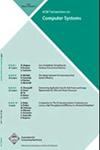设备配置的声明性语言方法
IF 1.8
4区 计算机科学
Q2 COMPUTER SCIENCE, THEORY & METHODS
引用次数: 27
摘要
C仍然是硬件编程(设备驱动程序,总线配置等)的首选语言:它速度快,允许低级访问,并且受到操作系统开发人员的信任。然而,配置和重新配置硬件设备和互连所需的算法正变得越来越复杂和多样化,还要解决遗留支持、“怪癖”和硬件错误带来的额外负担。甚至在现代PC中编程PCI桥也是一个非常复杂的问题,并且随着热插拔等新功能的出现而变得越来越糟糕。现有的方法使用相对简单的算法,用C语言硬编码,并与低级寄存器访问代码紧密结合,通常会导致次优配置。我们研究了一种新方法的优点和缺点:将硬件配置逻辑(确定配置参数值的算法)与机制(编程设备寄存器)分离。后者我们保存在C语言中,而前者我们使用具有约束满足扩展的声明性编程语言进行编码。作为测试用例,我们在Barrelfish研究操作系统中实现了完整的PCI配置,资源分配和中断分配,使用约束逻辑编程中高效算法的简明表达。我们的研究表明,该方法易于处理,并且可以成功地配置具有竞争力的运行时成本的各种pc。此外,它只需要Linux中基于c的方法一半的代码,同时提供更多的功能。此外,它很容易适应诸如热插拔、固定区域和“怪癖”之类的适应性。本文章由计算机程序翻译,如有差异,请以英文原文为准。
A Declarative Language Approach to Device Configuration
C remains the language of choice for hardware programming (device drivers, bus configuration, etc.): it is fast, allows low-level access, and is trusted by OS developers. However, the algorithms required to configure and reconfigure hardware devices and interconnects are becoming more complex and diverse, with the added burden of legacy support, “quirks,” and hardware bugs to work around. Even programming PCI bridges in a modern PC is a surprisingly complex problem, and is getting worse as new functionality such as hotplug appears. Existing approaches use relatively simple algorithms, hard-coded in C and closely coupled with low-level register access code, generally leading to suboptimal configurations.
We investigate the merits and drawbacks of a new approach: separating hardware configuration logic (algorithms to determine configuration parameter values) from mechanism (programming device registers). The latter we keep in C, and the former we encode in a declarative programming language with constraint-satisfaction extensions. As a test case, we have implemented full PCI configuration, resource allocation, and interrupt assignment in the Barrelfish research operating system, using a concise expression of efficient algorithms in constraint logic programming. We show that the approach is tractable, and can successfully configure a wide range of PCs with competitive runtime cost. Moreover, it requires about half the code of the C-based approach in Linux while offering considerably more functionality. Additionally it easily accommodates adaptations such as hotplug, fixed regions, and “quirks.”
求助全文
通过发布文献求助,成功后即可免费获取论文全文。
去求助
来源期刊

ACM Transactions on Computer Systems
工程技术-计算机:理论方法
CiteScore
4.00
自引率
0.00%
发文量
7
审稿时长
1 months
期刊介绍:
ACM Transactions on Computer Systems (TOCS) presents research and development results on the design, implementation, analysis, evaluation, and use of computer systems and systems software. The term "computer systems" is interpreted broadly and includes operating systems, systems architecture and hardware, distributed systems, optimizing compilers, and the interaction between systems and computer networks. Articles appearing in TOCS will tend either to present new techniques and concepts, or to report on experiences and experiments with actual systems. Insights useful to system designers, builders, and users will be emphasized.
TOCS publishes research and technical papers, both short and long. It includes technical correspondence to permit commentary on technical topics and on previously published papers.
 求助内容:
求助内容: 应助结果提醒方式:
应助结果提醒方式:


